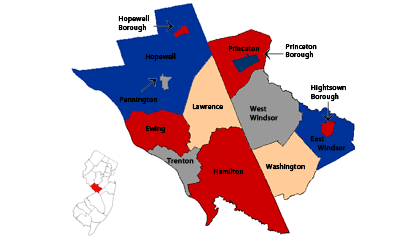If it's broke, why not fix it?
March 30, 2011 — As Remapping Debate recently reported, New Jersey’s fiscal problems have given rise to an intense debate between the state and its municipalities about the fairest and most effective way to close the state’s budget gap. But while local officials claim to be open to creative ways to deliver services more effectively, most stop short when it comes to one promising but politically difficult option: municipal consolidation.
For several decades, economists and good-government advocates (as well as some state officials) have pointed to New Jersey’s fragmented system of 566 municipal governments (in addition to separate school districts and county governments) as a key source of the state’s fiscal problems and high property taxes, and have identified millions of dollars in potential savings if the number of local governments were reduced. In addition to the fiscal benefits, there may be other advantages, including better service delivery and less economic segregation between towns.
But several efforts over the years by the state to encourage the consolidation of small municipalities have failed to produce significant results, and only one consolidation has taken place in the last 50 years.
In 2007, consolidation advocates were given new hope. The state legislature created the Local Unit Alignment, Reorganization and Consolidation Commission to facilitate consolidations while shielding state and local officials from the political fallout those officials fear might occur, even when such consolidations would serve the interests of both local residents and the state as a whole.
LUARCC was charged with studying and reporting on the ways that municipal governments could operate more efficiently, and on the ways that the state government could facilitate the process of consolidation and shared services. Most notably, LUARCC was given the authority to recommend specific consolidations, proposals that residents would have to vote up or down.
Four years later, many of LUARCC’s responsibilities have not been fulfilled, and potential municipal consolidations remain stalled. The reason, commission members say, is lack of funding. Despite Gov. Christie’s professed support for consolidation, even for his own hometown, his 2010 budget completely defunded the commission, and no funds have been restored this year.
Given the substantial and permanent cost-savings that could result from numerous consolidations, and the fact that LUARCC’s funding comprised only a tiny portion of New Jersey’s overall budget, questions have been raised about the wisdom of not allowing LUARCC the opportunity to see if its mechanisms could have overcome local resistance to change. And, some advocates say, the decision to defund LUARCC obscures municipal consolidation as a viable alternative to a locality that is currently choosing between reducing services or raising property taxes beyond a state-imposed cap.
A complicated process in a highly fragmented state
Though several states, including New York, Pennsylvania, and Iowa, are wrestling with the issue of municipal fragmentation, New Jersey has received the most attention because of its vast number of jurisdictions, and the direct link, made by many, to the state’s high property taxes.
New Jersey has more municipalities — both per-person and per-square-mile — than any other state in the country. There are more local governments for New Jersey’s 8.8 million residents than for California’s 37.3 million. There are several historical reasons for this fragmentation dating back to the founding of the colony: some municipalities, for example, split off from larger towns to avoid the prohibition of liquor sales there; others were formed in order to facilitate the exclusion of African-Americans.
Home rule: New Jersey’s religion? (part 1)
Many advocates of municipal consolidation cite the battle cry of “home rule” as the single, most difficult obstacle to overcome.
Home rule — the insistence that a variety of governing decisions be kept at the most local level possible — is supported both with the rationale that elected officials are more responsive to a smaller group of citizens they know, and with the justification that a community’s “identity” can only be maintained if a broader, oftentimes more heterogeneous group is not allowed to dilute or taint that identity.
“The major impediment to [consolidation] is the concept of home rule and the fact that people enjoy living in a community that is unique,” said State Senator Robert Gordon. Others have suggested that the discussion of home rule can sometimes serve as a code for exclusion and segregation (see related box on page 3).
New Jersey’s affinity for home rule is nothing new. Brendan Byrne, who served as the Governor of New Jersey from 1974 to 1982, once said that “Home rule in New Jersey is a religion.”
Kevin Roberts of Gov. Christie’s office acknowledged that home rule had led to an inefficient system of governance in New Jersey.
“[Home rule], while long a part of New Jersey’s governmental landscape, has ultimately led to layers and layers of government at a significant cost to taxpayers,” Roberts wrote in an email. “Given the difficult fiscal circumstances we live in now, it’s time to move past the notion that we can have sacred cow issues, including home rule, that come with unsustainable costs.”
“There’s this idea that people are going to lose their community’s identity if they consolidate,” Gina Genovese, executive director of Courage to Connect New Jersey, agreed. “I’m trying to show them that that’s not the case.”
Anton Lahnston from the Princeton consolidation study commission agreed that community identity played a part in residents’ fear of change. “People said to me, ‘I’m afraid we’ll lose the borough-ness,’” he said. “I asked, ‘What’s the borough-ness?’ Sometimes they don’t know, but it means something to some people.”

